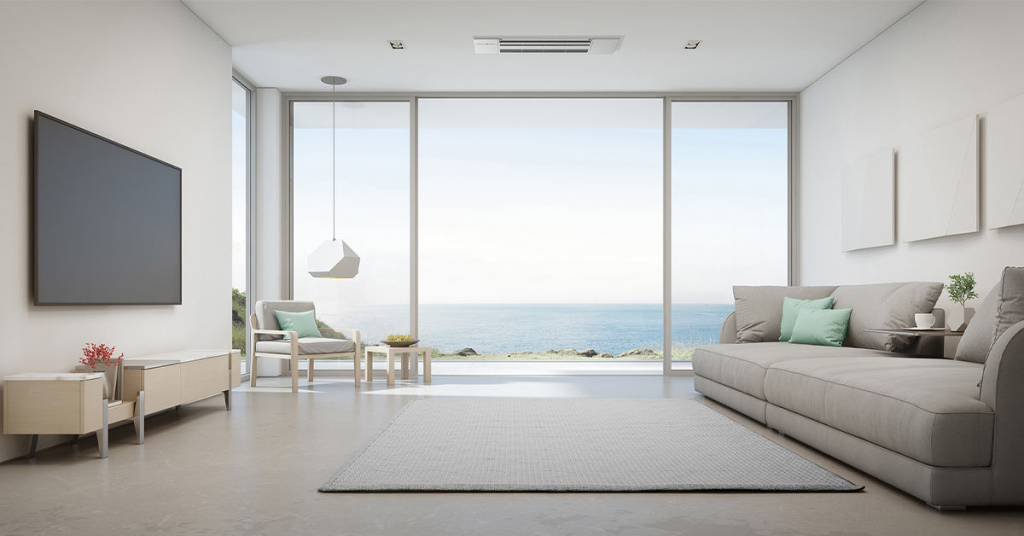When it comes to efficient and stylish cooling options for your home or office, a ceiling mini split air conditioner stands out as an excellent choice. These systems offer a sleek, unobtrusive design and top-notch performance, making them ideal for spaces where both functionality and aesthetics are priorities.

In this comprehensive guide, we’ll explore the benefits, features, installation, and maintenance tips for ceiling mini split air conditioners, ensuring you have all the information you need to make an informed decision.
What Is a Ceiling Mini Split Air Conditioner?
A ceiling mini split air conditioner is a ductless HVAC system with an indoor unit installed on or recessed into the ceiling. Unlike traditional wall-mounted units, these systems blend seamlessly with your room’s decor, offering an elegant cooling solution without sacrificing functionality.
Components of a Ceiling Mini Split System:
- Indoor Unit: Mounted on or inside the ceiling to deliver cool air evenly throughout the room.
- Outdoor Unit: Houses the compressor and condenser, placed outside the building.
- Refrigerant Lines: Connects the indoor and outdoor units, facilitating heat exchange.
- Remote Control: Enables easy operation and temperature adjustments.
Read too: Kitchen Lighting For A Vaulted Ceiling: Illuminating Your Space with Style and Functionality
Benefits of a Ceiling Mini Split Air Conditioner
1. Sleek and Space-Saving Design
The ceiling-mounted design ensures that the air conditioner doesn’t take up wall or floor space, keeping the room clutter-free and maintaining a modern aesthetic.
2. Efficient Cooling and Heating
Most ceiling mini splits are equipped with inverter technology, which adjusts the compressor speed to maintain the desired temperature efficiently. They also often function as heat pumps, providing year-round climate control.
3. Quiet Operation
Designed with noise reduction in mind, these units operate at whisper-quiet levels, making them perfect for bedrooms, offices, and other noise-sensitive areas.
4. Zone Control
Ceiling mini split systems allow you to cool or heat individual rooms independently, saving energy by only conditioning the spaces you’re using.
5. Energy Efficiency
Thanks to advanced technology like variable speed compressors and precise temperature control, these systems consume less energy than traditional HVAC units.
Types of Ceiling Mini Split Air Conditioners
Choosing the right type of ceiling mini split system depends on your specific needs and room layout:
1. Ceiling Cassette Mini Split
- Installed flush with the ceiling, this type disperses air in multiple directions for even cooling.
- Best suited for larger spaces with suspended ceilings.
2. Ceiling-Suspended Mini Split
- Mounted below the ceiling, it’s ideal for rooms with high ceilings or without access to a recessed installation.
- Delivers powerful airflow and is commonly used in commercial settings.
3. Ducted Mini Split
- Hidden within the ceiling or attic, it uses short ducts to distribute air.
- Combines the aesthetics of central air with the efficiency of a mini split system.
Installation Process
Installing a ceiling mini split air conditioner requires professional expertise to ensure proper placement, performance, and safety. Here’s an overview of the process:
1. Site Assessment
A technician evaluates the room layout, ceiling type, and cooling requirements to determine the best unit type and placement.
2. Installing the Indoor Unit
The indoor unit is mounted or recessed into the ceiling. This step often requires structural modifications for proper fit and stability.
3. Connecting the Refrigerant Lines
Refrigerant lines are routed through walls or ceilings to connect the indoor and outdoor units.
4. Mounting the Outdoor Unit
The outdoor unit is installed on a stable surface, ensuring proper airflow and easy access for maintenance.
5. Testing the System
Once installed, the system is tested for efficiency, refrigerant levels, and temperature control.
Choosing the Right Ceiling Mini Split Air Conditioner
To find the best ceiling mini split air conditioner for your space, consider these key factors:
1. Room Size
Choose a unit with the appropriate BTU (British Thermal Unit) rating for your room size. Oversized or undersized units can lead to inefficiency and uneven cooling.
2. Energy Efficiency Ratings
Look for units with high SEER (Seasonal Energy Efficiency Ratio) and HSPF (Heating Seasonal Performance Factor) ratings to ensure long-term energy savings.
3. Aesthetic Preferences
Select a design that complements your interior decor, whether it’s a recessed cassette or a suspended unit.
4. Smart Features
Consider models with advanced features like Wi-Fi connectivity, programmable timers, and eco-friendly refrigerants for added convenience and sustainability.
5. Budget
Include the cost of the unit, installation, and maintenance in your budget. While ceiling mini splits may have higher upfront costs, their energy efficiency and longevity can lead to savings over time.
Maintenance Tips for Ceiling Mini Split Systems
To keep your ceiling mini split air conditioner running efficiently, regular maintenance is crucial:
1. Clean the Filters
Dust and debris can accumulate in the filters, reducing airflow and efficiency. Clean or replace filters every one to three months.
2. Inspect the Refrigerant Lines
Check for leaks or damage in the refrigerant lines, which can impact the system’s performance.
3. Keep the Outdoor Unit Clear
Ensure the outdoor unit is free from obstructions like leaves or debris, which can restrict airflow.
4. Schedule Professional Servicing
Annual servicing by a professional technician helps identify potential issues and keeps the system in optimal condition.
Cost of Ceiling Mini Split Air Conditioners
The cost of a ceiling mini split system varies based on the unit type, BTU rating, and installation complexity:
- Unit Price: $1,500–$4,500
- Installation Costs: $500–$2,000 (depending on modifications required)
- Maintenance Costs: Around $100–$300 annually
While the upfront cost may seem high, the energy savings and durability of these systems make them a worthwhile investment.
Why Choose a Ceiling Mini Split Air Conditioner?
Ceiling mini split air conditioners offer the perfect balance of efficiency, aesthetics, and versatility. They are an excellent choice for modern homes and businesses seeking reliable and unobtrusive climate control. Whether you’re upgrading an existing system or installing one in a new space, a ceiling mini split can deliver comfort, convenience, and long-term savings.









